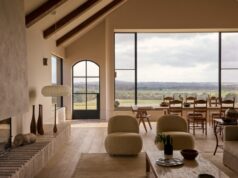
Find out more about how to match the materials and overall style of a vanity to your bathroom.
The choice of material you make for your vanity is likely to depend largely on the look you’re trying to achieve. The style of vanity you choose will often be determined by the materials too; while it’s possible to have a thick stone counter top on a small wall mounted unit, it is not recommended for weight reasons.

Wooden cabinets and benches
Most vanities will be constructed of wood, but may use a different material for the bench top. Whether the wood is furniture-quality exposed wood such as oak or maple or a laminated chipboard base, it will need to be water resistant and easy to clean. Wood is a relatively versatile, lightweight and cheap medium to work with, and you will be spoiled for choice with the current market range. If you choose to use exposed wood you will need to be careful not to stain any exposed wood; stains can be removed with some light sanding but you will need to reseal the wood again which may require a lot of work.
Glass benchtops and basins
Glass is an increasingly popular material to use for both basins and vanities. Glass can be fully transparent or semi opaque, and comes in an exquisite range of colours and textures. Vanities using glass are designed to be eye-catching, and are very low maintenance – no staining to worry about. The only downside to using glass is the risk of possible breakage. Small cracks to glass benches or basins may quickly expand in a bathroom as the heat fluctuates frequently, so you will likely need to replace the damaged portion soon if an accident does occur.
Stone basins and benchtops
Stone basins and countertops have always been something of a high-brow option, and bring a touch of class to any bathroom they appear in. Marble, granite and quartz look amazing when used in the right contexts, and will last a very long time when they’re given right care. Stone is also quite heavy (as you would expect), so if you do choose to use a stone basin or benchtop you should also ensure that your cabinet is built in a way that is able to properly support it.
Despite its appearance, stone is a porous material, so if it’s left exposed or scratched it can absorb and retain water. Stains are difficult to remove from stone, as the stain often sits well below the surface and can’t simply be scrubbed out. There are other manufactured composite stone types available too, such as caesarstone which is 95% quartz and 5% polymer resins. The addition of the resins makes the surface more scratch resistant and less porous.
Porcelain benches and basins
The majority of bathroom basins are made from porcelain. Porcelain sinks are relatively inexpensive, versatile and very easy to clean. Porcelain basins are always white and opaque, but in most bathrooms this isn’t a serious handicap. Another advantage of porcelain is that it’s easily moulded to just about any shape basin you can think, which opens up a lot of options for custom designs. Porcelain is highly resistant to stains and is non-porous for as long as the finish lasts, although it is prone to chipping and cracking if it’s treated roughly.
Laminate, acrylic and resin benchtops
Laminate, acrylic and resin benches are practical, versatile and inexpensive. While they could theoretically be any colour, they are most often white, or a not-too-distant variation on the shade. Unless they’re specially coated or treated, these types of benchtops are susceptible to staining, so if you do choose one you should be especially cautious with things like hair dyes and rust. Most stains can be removed easily enough, but permanent marks will always stand out on these surfaces, especially if they are normally uniformly textured and coloured.





